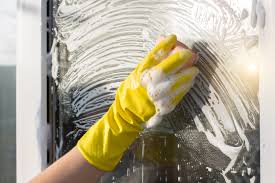We get this call from time to time.
Unlike famous toxic black mould, Stachybotrys, the pink “mould” in your shower isn’t actually mould at all. The discoloration comes from a biofilm—that is, a bacterial colony—of Serratia marcescens. The airborne bacterial species thrives in moist environments like showers, where it feeds on mineral deposits in soap scum and fatty deposits in soap and shampoo residue.
While it’s harmless to most healthy people whose skin may brush up against the pink mould in a narrow shower, it can cause various ailments (e.g. urinary tract or bladder infections) if it enters the body through the eyes or open wounds. The severity and variety of these ailments increases in individuals with compromised immune systems. Better safe than sorry: It’s best to remove the biofilm before the bacteria multiply and your exposure to it increases.

So let’s get rid of it.
The stubborn biofilm of Serratia marcescens can only be removed through agitation and elbow grease. Start by mixing up a slightly runny paste consisting of a quarter-cup baking soda and a tablespoon of liquid dish soap in a small bowl. Suit up in gloves, protective glasses, and a respirator to limit your exposure to the bacteria, then dip the bristles of a soft-bristle scrub brush into the prepared paste and vigorously scrub down any visible patches of biofilm on hard surfaces in the shower (e.g. countertops, shower chairs, doors, and tile and grout lines on walls and floors). This process should loosen and lift the biofilm.

When you’re finished scrubbing, rinse away any loosened biofilm in the shower by either wiping down the scrubbed areas with a wet towel or turning on and detaching the shower head to flush the slime down the drain.
Disinfect these same shower surfaces where you had seen the pink mould.
It’s not enough to simply scrub away the color; you need to disinfect the surface to remove any lingering bacteria to prevent its return. Bleach is your best bet since it does double-duty to kill the last of the bacteria and dissolve stubborn stains left in its wake. Mix chlorine bleach and warm water half and half spray bottle, then replace the cap and gently shake the bottle. Spray the solution directly over the hard surfaces of the shower you’ve scrubbed and let the solution dwell in the shower for 10 minutes. Then use a fresh soft-bristle scrub brush to lightly scrub down the sprayed areas, rinse once more, and dry the shower surfaces with a clean towel or squeegee.
Keep biofilm at bay.
Pink mold is one stubborn biofilm that often reappears on hard and soft shower surfaces even after you’ve taken these outlined measures to remove it. Make your bathroom cleaning responsibilities easier on yourself by heeding these tips for preventing new biofilm from forming:
- Serratia marcescens is more likely to spread in damp areas, so towel-dry or squeegee the hard surfaces of your shower after every use to remove excess water.
- Use a water-dampened paper towel to wipe away soap or shampoo residue anywhere it collects in the shower after every use. Then, make a second pass over these areas with a dry paper towel.
- Remove soap scum from hard shower surfaces on a biweekly basis. Spray soap-scum-riddled areas of the shower with a 50-50 solution of white vinegar and warm water combined with one tablespoon of dish soap, and let the solution dwell for 15 minutes. Then scrub down the sprayed areas with a soft-bristle brush. Rinse away anything you’ve loosened from the tile and glass, and towel-dry or squeegee all wet surfaces.
- Machine-wash shower curtains, if you have them, on a monthly basis in a gentle cycle with warm water.
- Turn on your bathroom’s exhaust fan before you shower and leave it on for 20 minutes afterward to help dry out the air in the room. The pink stuff is more likely to spread when there is excess moisture in the air.
Hope this helps.
